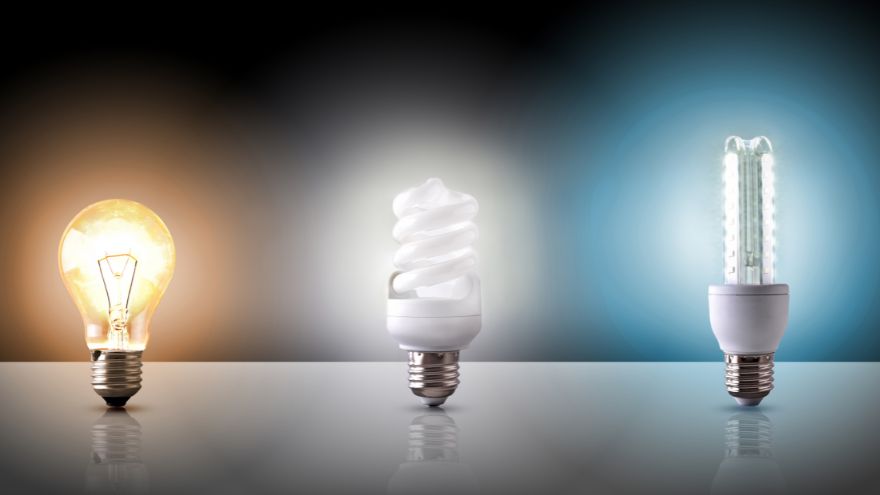Choosing the right lighting is an important step towards greater comfort, energy savings, but also caring for the environment. The market offer is very rich in this respect, as energy-saving, modern light bulbs are available as popular LEDs, compact fluorescent bulbs (CFL) and halogen. All of these models have their unique features, strengths and weaknesses that can affect the purchase decision. In the following article, we will deal with this topic in detail, analyzing, among other things, what types of LED bulbs are and how do they differ from CFLs? We will also discuss the energy efficiency of halogen bulbs to help you make an informed choice of the optimal light source, i.e. one that meets the most important requirements - in terms of lighting quality and energy efficiency.

Check out the LED bulbs at the Onninen wholesaler
What types of LED bulbs are there?
LED (Light Emitting Diode) bulbs are undoubtedly one of the most popular and energy-efficient light sources. They are chosen for various places, both homes, apartments and commercial spaces. Thanks to advanced diode technology, they are available in many different versions, so you can adjust them to your individual needs.
 LED bulbs with different bases are common, especially E27 (standard thread), E14 (smaller thread) and GU10 (used mainly in spotlights). However, there is also LED lighting dedicated to special applications. One example is tubular bulbs designed for under-cabinet lighting or LED strips, perfect for decorative interior lighting.
LED bulbs with different bases are common, especially E27 (standard thread), E14 (smaller thread) and GU10 (used mainly in spotlights). However, there is also LED lighting dedicated to special applications. One example is tubular bulbs designed for under-cabinet lighting or LED strips, perfect for decorative interior lighting.
It is worth remembering, however, that diversity also refers to the color of light - from warm white (2700-300 K), through neutral (4000 K), to cold white (5000-6500 K). You can therefore adjust this color depending on the needs and character of the interior. Equally important, many modern LED bulbs provide various functions, such as brightness adjustment or control via an application or remote control, which is extremely convenient.
The biggest advantage of LED bulbs, however, is their low energy consumption, which is why many people choose this solution when choosing a light source . Especially since these types of fluorescent bulbs are characterized by a long service life, so they last for a very long time.
What is the difference between an LED and a CFL bulb?
Although LED sources are very popular, and therefore very often chosen for various applications (not only as main lighting, but also decorative), CFL (Compact Fluorescent Lamp) bulbs are also quite popular. Both are energy-saving, but they differ from each other not only in their operating technology, but also in practical features of use.
 LEDs use light-emitting diodes, which emit light directly. This makes them more energy-efficient. This is different from CFLs, which are miniature fluorescent lamps in which light is produced by discharges in a gas that excites a phosphor.
LEDs use light-emitting diodes, which emit light directly. This makes them more energy-efficient. This is different from CFLs, which are miniature fluorescent lamps in which light is produced by discharges in a gas that excites a phosphor.
Another very important difference is the warm-up time. LEDs reach full brightness very quickly, immediately after switching on, CFL bulbs need more time - a few seconds, and sometimes a few minutes to fully illuminate.
When talking about differences, it is also worth noting durability. LED bulbs have an average lifespan of a high level, from 15 to 25 thousand hours, while CFLs have a slightly shorter lifespan, around 8-10 thousand hours. LEDs also show greater resistance to frequent switching on and off. This can shorten the lifespan of CFLs.
The ecological perspective is also important here, as CFLs contain small amounts of mercury, which requires special disposal. LEDs are more environmentally friendly in this respect.
Energy saving and halogen bulbs
Halogen bulbs are an improved version of traditional incandescent bulbs. They provide much higher energy efficiency and better light quality. Halogen gases such as iodine or bromine are used here, thanks to which the bulb filament operates at a higher temperature, which translates into brighter light while using less energy. However, compared to CFL bulbs, and even more so to LEDs, halogens are much less energy efficient.
 On the one hand, halogens use about 20-30% less energy than traditional bulbs, but on the other hand, their energy efficiency is nowhere near modern technologies. It lags far behind. Their lifespan is also poor - from 2 to 4 thousand hours, so they need to be replaced much more often than LEDs, which - as we already know - can last up to 10 times longer!
On the one hand, halogens use about 20-30% less energy than traditional bulbs, but on the other hand, their energy efficiency is nowhere near modern technologies. It lags far behind. Their lifespan is also poor - from 2 to 4 thousand hours, so they need to be replaced much more often than LEDs, which - as we already know - can last up to 10 times longer!
Halogens also have their advantages, of course, especially their natural color, as well as the fact that they immediately reach full brightness. However, this is not enough when we consider their energy consumption. This is the reason why this type of fluorescent lamp is increasingly being replaced from the market in favor of more advanced solutions.